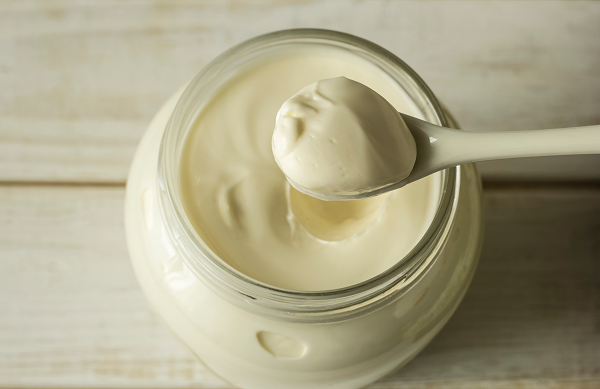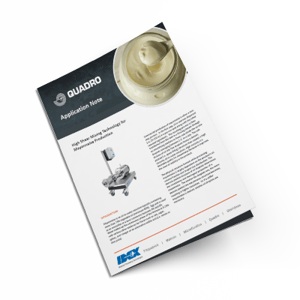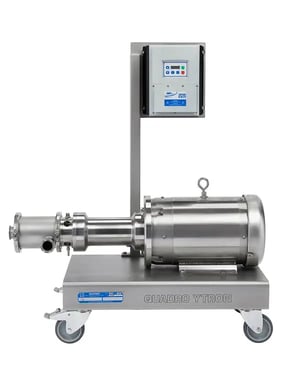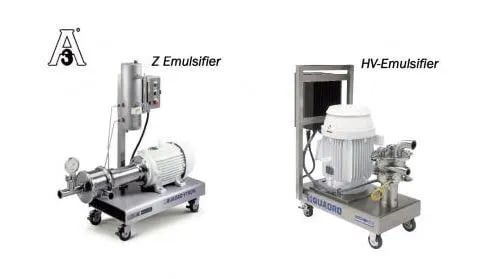How is Mayonnaise made?
Mayonnaise is an oil-in-water emulsion typically containing more than 74% vegetable oil (minimum 65%).
Production of Mayonnaise
In mayonnaise production, egg yolk is used as an emulsifier at a level commonly between 4% and 8%. Water makes up the continuous phase of the formula at 5-15% with various other additives for flavor such as salt, sugar, spices and vinegar or an alternative edible acid (i.e. lemon or lime juice).
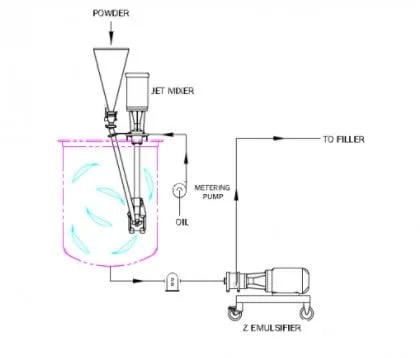
Mayonnaise Manufacturing Process
Commercial mayonnaise production is often a two-step process. In the first step, oil is coarsely dispersed (i.e. 20-100μm) in a pre-mix tank along with the other required ingredients. The resulting pre-mix is then transferred from the tank in a flowing stream through an emulsifying machine to finely sub-divide the oil into droplets averaging between 1-5μm in size.
The sub-division of oil into fine droplets forms a densely packed (i.e. space-filling) structure that creates a high viscosity oil-in-water emulsion. High viscosity is a desirable quality for industrial mayonnaise because it improves the level of stability in the product.
The physical structure formed during mayonnaise processing is largely dependent on the product’s oil volume fraction and droplet size distribution. The densely packed structure of oil droplets determines the consistency and rheological properties of mayonnaise. The smaller the droplets are, the more densely packed the mayonnaise structure becomes, resulting in higher viscosities. So if stiffer mayonnaise is desired, mayonnaise equipment capable of producing smaller oil droplets is necessary.
Download the Application Note for Mayonnaise Production
Commercial Mayonnaise Production Solutions
The Quadro Ytron® Jet Mixer configured with our bypass dispersion assembly is ideally suited to the first step of commercial mayonnaise production — mayonnaise preparation — with the ability to disperse powders or liquid ingredients sub-surface in the pre-mix. Sub-surface dispersion through the Jet Mixer head prevents powder lumps and agglomerates from forming, while also creating a uniform distribution of course oil droplets for the next step of processing.
This mayonnaise manufacturing equipment delivers uniform distribution in the pre-mix, improving the reliability of droplet size reduction in the emulsifier while producing more consistent stability in the mayonnaise.
For the second step of the mayonnaise production process, the mayonnaise pre-mix can either be pumped through a Quadro Ytron® Z-Emulsifier or a Quadro® HV-Emulsifier.
If a typical mayonnaise is desired with droplet sizes between 1-5μm, the Z Emulsifier is an ideal solution. The Z Emulsifier allows custom selection of up to three stages of rotor-stator tooling to meet the needs of processing mayonnaise at a higher capacity than a colloid mill while maintaining a single-pass process. If a stiffer mayonnaise is desired our new HV-Emulsifier can be used to significantly reduce oil droplet size (i.e. below 1μm is possible), and more easily attain a densely packed structure, resulting in a higher viscosity product.
Mayonnaise Manufacturing Equipment
The consistency and properties of mayonnaise can be finely tuned with a mayonnaise emulsifier such as our Z Emulsifier or an HV, depending on the desired qualities.
Quadro's Emulsifying technology provides the end-user with mayonnaise processing equipment that achieves the desired results in a single pass and significantly shorter batch times.
Get in touch with our team for expert advice and recommendations.
Video: Impact of Tip Speed on Mayonnaise Production
Quadro Liquids Processing demonstrates the impact of rotor-stator tip speed on the viscosity of a mayonnaise emulsion using a Quadro HV High Shear Homogenizer & Wet Mill.
The process begins with an egg and water mixture within the tank with the Y-Jet mixture. The Y-Jet in-tank mixer is dispersing the oil phase into the tank, slowly increasing the flow rate until the pre-mix or pre-emulsion is completed.
This water, egg and oil emulsion will then be fed through the Quadro HV Emulsifier and Wet Mill. The high-speed design of the HV enables accelerated rotor/stator velocities and an exponential increase in process shear energy. The HV is capable of producing more than 55x the high shear energy of a conventional rotor/stator mill.
Related Reading
- Using A Emulsifier and Mixer for Mayonnaise Production
- Quadro Liquids Food Mixing Solutions
- Oil In Water And Water In Oil Emulsions: What's The Difference?
Arrange a call back from a member of our team
If you have a particular issue that you are investigating then please don't hesitate to contact us. Phone inquiries can also be made +1-519-884-9660.
In nearly 20 years of delivering the most efficient mixing and processing solutions to our customers worldwide, Quadro Liquids technology has never allowed conventional thinking to get in the way. We continually develop innovative solutions that exceed expectations and break traditional assumptions about processing limitations.

